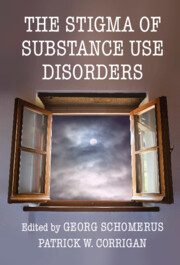Book contents
- The Stigma of Substance Use Disorders
- The Stigma of Substance Use Disorders
- Copyright page
- Contents
- Figures
- Tables
- Contributors
- Chapter 1 Understanding the Stigma of Substance Use Disorders
- Chapter 2 My Experience with the Stigma of Substance Use
- Chapter 3 Substance Use Stigma and Policy
- Chapter 4 Experiences of Stigma and Criminal In/Justice among People Who Use Substances
- Chapter 5 Substance Use Disorders, Stigma, and Ethics
- Chapter 6 Intersectional Stigma in Substance Use Disorders
- Chapter 7 International Perspectives on Stigma toward People with Substance Use Disorders
- Chapter 8 Using Community-Based Participatory Research to Address the Stigma of Substance Use Disorder
- Chapter 9 Three Competing Agendas of Addressing Stigma of Substance Use Disorder
- Chapter 10 The Benefits of Disclosure
- Chapter 11 The Role of Peers in SUD Stigma Change
- Chapter 12 The Role of Media Reporting for Substance Use Stigma
- Chapter 13 Reducing Substance Use Stigma in Health Care
- Chapter 14 Final Considerations and Future Directions for Erasing the Stigma of Substance Use Disorders
- Index
- References
Chapter 13 - Reducing Substance Use Stigma in Health Care
Published online by Cambridge University Press: 23 June 2022
- The Stigma of Substance Use Disorders
- The Stigma of Substance Use Disorders
- Copyright page
- Contents
- Figures
- Tables
- Contributors
- Chapter 1 Understanding the Stigma of Substance Use Disorders
- Chapter 2 My Experience with the Stigma of Substance Use
- Chapter 3 Substance Use Stigma and Policy
- Chapter 4 Experiences of Stigma and Criminal In/Justice among People Who Use Substances
- Chapter 5 Substance Use Disorders, Stigma, and Ethics
- Chapter 6 Intersectional Stigma in Substance Use Disorders
- Chapter 7 International Perspectives on Stigma toward People with Substance Use Disorders
- Chapter 8 Using Community-Based Participatory Research to Address the Stigma of Substance Use Disorder
- Chapter 9 Three Competing Agendas of Addressing Stigma of Substance Use Disorder
- Chapter 10 The Benefits of Disclosure
- Chapter 11 The Role of Peers in SUD Stigma Change
- Chapter 12 The Role of Media Reporting for Substance Use Stigma
- Chapter 13 Reducing Substance Use Stigma in Health Care
- Chapter 14 Final Considerations and Future Directions for Erasing the Stigma of Substance Use Disorders
- Index
- References
Summary
Although health care is generally designed to help people, it has the potential to effectively impede recovery for people using substances by obvious and subtle discrimination. Stigmatizing attitudes among health professionals are common, regularly expected by people who use substances and potentially reduce quality of delivered clinical care. The power gradient that drives stigma and discriminatory behavior is particularly palpable in the healthcare setting and prevalent within different clinical situations like emergency medicine, primary care, and the psychiatric ward as within language. Comprising the current evidence of interventions, specific clinical settings and language regarding substance use stigma, we suggest recommendations for changes in clinical practice. Professionals need to avoid inflicting very real harm by increasing shame and reducing self-worth through stigmatizing settings, language, and concepts. Reducing substance use stigma is an integral and profoundly important part of caring for people who use substances and should be considered as such.
- Type
- Chapter
- Information
- The Stigma of Substance Use Disorders , pp. 232 - 251Publisher: Cambridge University PressPrint publication year: 2022
References
- 4
- Cited by

